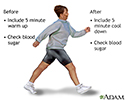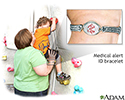Diabetes and exercise
Exercise is an important part of managing your diabetes . If you are obese or overweight, exercise can help you manage your weight.
Diabetes
Diabetes is a chronic disease in which the body cannot regulate the amount of sugar in the blood.

Exercise can also help lower your blood sugar without medicines . It reduces your risk of heart disease and stress.
Lower your blood sugar without medicine
Hyperglycemia - control; Hypoglycemia - control; Diabetes - blood sugar control; Blood glucose - managing

But be patient. It may take several months of exercising before you see changes in your health.
Talk to Your Doctor First
Your health care provider should make sure your exercise program is safe for you.
Call your provider if you feel faint, have chest pain, or feel short of breath when you exercise.
Call your provider if you feel pain or numbness in your feet. Also call if you have sores or blisters on your feet.
Make sure you call your provider if your blood sugar gets too low or too high during the day.
If you take medicines that lower your blood sugar, exercise can make your blood sugar go too low. Talk to your provider or nurse about how to take your medicines when you exercise.
Some types of exercise can make your eyes worse if you already have diabetic eye disease . Get an eye exam before starting a new exercise program.
Getting Started
Start with walking. If you are out of shape, walk for 5 to 10 minutes a day.
Try to set a goal of fast walking. You should do this for 30 to 45 minutes, at least 5 days a week. In order to lose weight, the amount of exercise may need to be greater. So do more if you can. Swimming or exercise classes are also good.
Wear a bracelet or necklace that says you have diabetes. Tell coaches and exercise partners that you have diabetes. Always have fast-acting sources of sugar with you, such as juice or hard candy. Carry a cell phone with emergency phone numbers with you, as well.
Drink plenty of water. Do this before, during, and after exercising. Try to exercise at the same time of day, for the same amount of time, and at the same level. This will make your blood sugar easier to control. If your schedule is less regular, exercising at different times of the day is still better than not exercising at all.
Your Blood Sugar and Exercise
Check your blood sugar before you exercise. Also, check it during exercise if you are working out for more than 45 minutes.
Check your blood sugar again right after exercise, and later on. Exercise can cause your blood sugar to drop for up to 12 hours after you are done.
If you use insulin, ask your provider when you should eat before you exercise. Also, find out how to adjust your dose when you exercise.
DO NOT inject insulin in a part of your body that you are exercising.
Keep a snack nearby that can raise your blood sugar quickly. Examples are:
- Five or six small hard candies
- One tablespoon (tbsp), or 15 ml, of sugar, plain or dissolved in water
- One tbsp (15 mL) of honey or syrup
- Three or four glucose tablets
- One half can (177 mL) of regular, non-diet soda
- One half cup (4 ounces or 125 mL) of fruit juice
Have a larger snack if you will be exercising more than usual. You can also have more frequent snacks. You may need to adjust your medicine if you are planning unusual exercise.
If exercise frequently causes your blood sugar to be low, talk with your provider. You may need to lower the dose of your medicine.
Your Feet and Exercise
Always check your feet for any problems before and after exercise. You might not feel pain in your feet because of your diabetes. You may not notice a sore or blister on your foot. Call your provider if you notice any changes on your feet. Small problems can become serious if they go untreated.
Check your feet for any problems
Diabetes - foot care - self-care; Diabetic foot ulcer - foot care; Diabetic neuropathy - foot care

Wear socks that keep moisture away from your feet. Also, wear comfortable, well-fitting shoes.
References
Eckel RH, Jakicic JM, Ard JD, et al. 2013 AHA/ACC guideline on lifestyle management to reduce cardiovascular risk: a report of the American College of Cardiology/American Heart Association Task Force on Practice Guidelines. Circulation . 2014;129(25 Suppl 2):S76-S99. PMID: 24222015 www.ncbi.nlm.nih.gov/pubmed/24222015 .
Kirk SE. The diabetic athlete. In: Miller MD, Thompson SR, eds. DeLee and Drez's Orthopaedic Sports Medicine: Principles and Practice . 4th ed. Philadelphia, PA: Elsevier Saunders; 2015:chap 21.
Standards of medical care in diabetes - 2016: summary of revisions. Diabetes Care . 2016;39:S4-S5. PMID: 26696680 www.ncbi.nlm.nih.gov/pubmed/26696680 .
-
Diabetes and exercise - illustration
A person with type 2 diabetes can use exercise to help control their blood sugar levels and provide energy their muscles need to function throughout the day. By maintaining a healthy diet and sufficient exercise, a person with type 2 diabetes may be able to keep their blood sugar in the normal non-diabetic range without medicine.
Diabetes and exercise
illustration
-
Medical alert bracelet - illustration
People with diabetes should always wear a medical alert bracelet or necklace that emergency medical workers will be able to find. Medical identification products can help ensure proper treatment in an emergency.
Medical alert bracelet
illustration
-
Diabetes and exercise - illustration
A person with type 2 diabetes can use exercise to help control their blood sugar levels and provide energy their muscles need to function throughout the day. By maintaining a healthy diet and sufficient exercise, a person with type 2 diabetes may be able to keep their blood sugar in the normal non-diabetic range without medicine.
Diabetes and exercise
illustration
-
Medical alert bracelet - illustration
People with diabetes should always wear a medical alert bracelet or necklace that emergency medical workers will be able to find. Medical identification products can help ensure proper treatment in an emergency.
Medical alert bracelet
illustration
Review Date: 5/17/2016
Reviewed By: Laura J. Martin, MD, MPH, ABIM Board Certified in Internal Medicine and Hospice and Palliative Medicine, Atlanta, GA. Also reviewed by David Zieve, MD, MHA, Isla Ogilvie, PhD, and the A.D.A.M. Editorial team.


